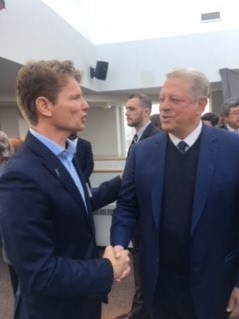The urgency of the climate crisis was felt at the Liberty Science Center in Jersey City, where former Vice-President Al Gore joined New Jersey Governor Phil Murphy in his announcement to more than double the state’s offshore wind goal. As I shook the hand of the Governor and former Vice-President to thank them, I couldn’t help but think of my 17-year-old son.

Like so many young climate activists around the globe, he asks tough questions around the dinner table about whether our government and other leaders are doing enough to address the climate and wildlife crisis.
This demand for action is certainly justified, as New Jersey and other Northeast residents experience global warming at a rate almost twice the national average. Climate change is affecting the range and availability of food for the state’s songbirds and exacerbating severe weather events that wash away shoreline habitat for piping plovers and northern diamondback terrapins.
The new Executive Order, signed on November 14, increases the state’s offshore wind energy goal from 3,500 megawatts by 2030 to 7,500 megawatts by 2035. This commitment translates into more than 3 million Garden State homes being powered with clean, renewable offshore wind energy. In a win for wildlife, the executive order “ensures that natural resources are protected throughout all stages of offshore wind energy development and generation.”
The National Wildlife Federation has been pushing for Northeastern states to make offshore wind policy commitments that include provisions for responsible development that protect wildlife and natural resources including coastal bird populations and marine mammals such as the highly-endangered North Atlantic right whale. With New Jersey’s increased commitment, coastal states from Maine to Virginia have committed to powering over 10 million homes with offshore wind energy.
This is no small feat. We are proud of the work we have done to make it happen, with the support of our members and donors, and leaders like Governor Murphy who bring the political will necessary to begin a new clean energy chapter. But there is much work left to do. We look forward to continuing to work alongside these states and our partners, to ensure offshore wind is developed in a way that helps to reverse the climate and wildlife crisis.
While this and other recent accomplishments fill my heart and spirit, the drumbeat for real change should get stronger with each victory until young people like my son are confident they can grow up with access to a livable environment.
We need to keep our focus on the big goals: creating a clean energy future, returning atmospheric levels of greenhouse gas to levels scientists deem safe, protecting wildlife, and creating a new economy that provides real opportunities for all people.
After we accomplish these ambitious, doable, and necessary goals, dinner table conversations will truly be different. We may even get one of those amazing, “Hey Dad, that is cool” comments that parents know come far and few between.
Support our work for wildlife in the Northeast.
 Offshore Wind Energy
Offshore Wind Energy 

